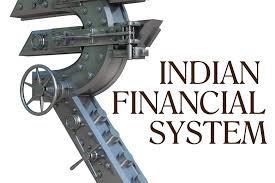NEP SEMESTER II DSC PAPER OF DEPARTMENT OF BUSINESS ECONOMICS
Learning Objectives
This course provides an understanding of the existing financial institutions and markets in the Indian financial system. Students will be equipped with the knowledge of primary and secondary segments of the equity, money, and debt markets.
Learning outcomes
By studying this course, the students will able to:
• To understand the role of banking and non-banking financial institutions in India.
DISCIPLINE SPECIFIC CORE COURSE – 5: FINANCIAL INSTITUTIONS
• To learn the methods for companies to raise funds in the primary market
• To use the methodology to create stock price indices in India.
• To analyze the process of issuance, trading, and settlement in equity, debt and money market instruments.
SYLLABUS OF DSC- 2
UNIT – I:Financial Institutions in India (9 Hours)
• Overview of Formal Financial System: Financial Institutions, Financial Markets, Financial Instruments, Financial Services, Role of Financial System in Economic Development.
• Banking and Non-Banking Institutions: Scheduled Commercial Banks in India, Risk Management Process in Banks, Non-Performing Assets, Tools to Manage Non-Performing Assets, Payment Banks.
• Credit Rating Agencies: Meaning, Methodology and Agencies in India.
• Housing Finance: Housing Finance Companies in India, Repricing of Loan, Floating vs. Fixed Rate, The Rest Method, Problems in Housing Finance.
• NBFCs in India: Objectives, Functions, Types, Difference between NBFCs and Banks, Role of NBFCs in Indian Economy.
• Regulatory Institutions: Reserve Bank of India (RBI), Securities Exchange Board of India (SEBI)
UNIT – II:Primary Market for Corporate Securities in India (15 Hours)
• Financial Markets: Role and Importance of Financial Markets, Types of Financial Markets-Equity Market, Debt market, Money market, Forex Market.
• Procedure of an IPO: Entry Norms for IPOs -Profitability Route, QIB Route, Appraisal Route; Intermediaries to an Issue, Pricing Methods-Fixed Price Process, Book Building Mechanism (Book Building Process, Bidding Process, Reverse Book Building, Limitations), Green Shoe option.
• Methods of Raising Funds: Venture Capital, Private Equity, Public Issues- IPO, FPO, offer for sale; Rights Issue, Private Placement -Preferential Issue, Qualified Institutional Placements, Disinvestment of PSU- Objectives, Sell-off methods.
• Raising of Funds from International Markets-ADRs, GDRs, FCCB and Euro Issues, Masala Bonds.
• Listing and Delisting of Corporate Stocks in Indian Stock markets.
UNIT – III:Secondary Market in India (12 Hours)
• Overview of Secondary Market: Functions of Secondary Market, Demutualization of Stock Exchange, Bulls and Bears in Stock Markets, Volatility and Circuit Breakers in stock Market, Stock exchanges in India; International stock exchanges, Capital Market Scams.
• Market Mechanism: Financial Instruments-Equity Shares, Debentures & Bonds, Derivatives. Types of Brokers, Depository Process in India.
• Trading, Clearing and Settlement of securities: Types of orders, Contract Note, Clearing Corporations (ICCL, NSCCL), Depositories (NSDL, CDSL), Settlement Mechanism.
• Risk Management: Margin Requirement and Capital requirement of a Broker, MTM and VaR Margins, Margin Trading and Margin Adjustments.
• Indian Stock Indices: Major Indices in India (Sensex and Nifty), Market Capitalization (free float, full float methodology), Calculation Methodology (Price weighted, Equal weighted, Fundamental weighted, Market Capitalisation weighted Index), Classification of Securities to be included in the Index, Impact of corporate actions (Rights, Bonus, and Stock split) on security prices and indices.
UNIT – IV: Money Markets & Debt Market in India (9 Hours)
• Money Market: Characteristics, Functions and Benefits of Efficient Money Market, Participants in money markets, Money Market Instruments- Auctioned Treasury Bills (Features, Types, and Issuance/Sale by Auction), Commercial Paper (Guidelines and Process for Issuance), Commercial Bills (Features and Types), Certificate of Deposits (Guidelines and Process for Issuance), Call/Notice Money (Reason of volatility and Process of Issuance) Repo, Reverse Repo.
• Long Term Debt Market: Participants and Instruments in Debt market, Private Corporate Debt Market-Issue and listing of Debt Securities; Govt Securities Market-Issuers, Investors and Types; Govt Dated Securities- Issuance, Trading and Settlement. RBI Direct Portal for retail investors for Government Securities
Notes:
1. The relevant rules, regulations and guidelines of the RBI, the SEBI and other regulators for all of the above topics should be covered.
Essential/recommended readings
1. Khan M. Y. Indian Financial System. Tata McGraw Hill.
2. Kannan, R., Shanmugam, K.R., &Bhaduri, S. Non-Banking Financial Companies-Role in India’s Development. Springer.
3. Pathak, B. Indian Financial System. Pearson.
4. Eakins, Stanley G. Finance: Investments, Institutions and Management. Addison-wesley Publications.
5. National Stock Exchange of India (2003), “Indian Securities Market: A Review”, NSE, Mumbai.
6. RBI Website- https://www.rbi.org.in/Scripts/NotificationUser.aspx?Id=12179&Mode=0
7. NSE website: https://www.nseindia.com/resources/publications-indian-securities-ismr
Suggested readings
1. Desai, V. Indian Financial System and Development. Himalaya Publishing House.
2. Gordan, E. Natarajan, K. Indian Financial System. Himalaya Publishing House.
3. Madura, J. Financial Markets and Institutions. Cengage Learning.
Note: Examination scheme and mode shall be as prescribed by the Examination
Branch, University of Delhi, from time to time.

- Teacher: Dr. Sultan Singh